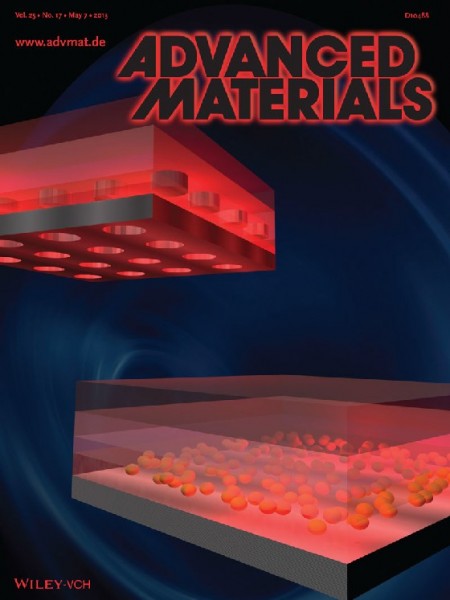May
14
Closer to a True Paint On Solar Panel
May 14, 2013 | 1 Comment
Gan is working on the use of plasmonic-enhanced organic photovoltaic materials. These devices don’t match traditional solar cells in terms of energy production but they are less expensive and – because they are made (or processed) in liquid form – can be applied to a greater variety of surfaces.
Gan’s team detailed the progress of plasmonic-enhanced organic photovoltaic materials in the May 7 edition of the journal Advanced Materials. An image of a plasmonic-enhanced organic photovoltaic device made the journal’s front page. Co-authors include Filbert J. Bartoli, professor of electrical and computer engineering at Lehigh University, and Zakya Kafafi of the National Science Foundation.

Plasmonic Enhanced Organic Solar Cell. Image Courtesy the University at Buffalo. Click image for the largest view.
Today’s solar panels produce power with either thick polycrystalline silicon wafers that are expensive to manufacture or thin-film solar cells made up of inorganic materials such as amorphous silicon or cadmium telluride that are somewhat less, but still costly to manufacture.
Gan’s research involves thin-film solar cells, too, but unlike what’s on the market he is using organic materials such as polymers and small molecules that are carbon-based and less expensive. “Compared with their inorganic counterparts, organic photovoltaics can be fabricated over large areas on rigid or flexible substrates potentially becoming as inexpensive as paint,” Gan said.
There are drawbacks to organic photovoltaic cells. They have to be thin due to their relatively poor electronic conductive properties. Because they are thin and, thus, without sufficient material to absorb light, it limits their optical absorption and leads to insufficient power conversion efficiency.
Gan points out the power conversion efficiency needs to be 10 percent or more to compete in the market.
To achieve that benchmark, Gan and other researchers are incorporating metal nanoparticles and/or patterned plasmonic nanostructures into organic photovoltaic cells. Plasmons are electromagnetic waves and free electrons that can be used to oscillate back and forth across the interface of metals and semiconductors.
Recent material studies suggest they are succeeding, he said. Gan and the paper’s co-authors argue that, because of these breakthroughs, there should be a renewed focus on how nanomaterials and plasmonic strategies can create more efficient and affordable thin-film organic solar cells.
Gan is continuing his research by collaborating with several researchers at UB including: Alexander N. Cartwright, professor of electrical engineering and biomedical engineering and UB vice president for research and economic development; Mark T. Swihart, UB professor of chemical and biological engineering and director of the university’s Strategic Strength in Integrated Nanostructured Systems; and Hao Zeng, associate professor of physics.
The idea that photovoltaic cells could one day be applied to surfaces as easily as paint is to walls had great appeal. Polls suggest when the questions are carefully set forth that most Americans want the U.S. to place more emphasis on developing solar power.
The handling of the solar panel power to grid alternating current would be the remaining investment expense. The Buffalo team deserves to have the progress seen and considered. They do have an argument on their hands, solar is in the doldrums and needs a boost. Really very low cost panel constructions and lower power conversion investments are going to come. The question is who can make the breakthroughs in a very tight research-funding environment.
Comments
1 Comment so far


Very nice post. I definitely appreciate this website.
Thanks!